- Home
- David Brin
The Transparent Society
The Transparent Society Read online
Many of the designations used by manufacturers and sellers to distinguish their products are claimed as trademarks. Where those designations appear in this book and Perseus Books was aware of a trademark claim, those designations have been printed with initial capital letters.
Library of Congress Catalog Card Number: 99-61238
eISBN : 978-0-465-02790-3
Copyright © 1998 by David Brin
All rights reserved.
No part of this publication may be reproduced, stored in a retrieval system, or transmitted, in any form or by any means, electronic, mechanical, photocopying, recording, or otherwise without the prior written permission of the publisher.
Books published by the Perseus Books Group are available at special discounts for bulk purchases in the United States by corporations, institutions, and other organizations. For more information, please contact the
Special Markets Department at the Perseus Books Group, 11 Cambridge Center, Cambridge, MA 02142,
or call (617) 252-5298, (800) 255-1514
or e-mail [email protected].
To Popper, Pericles, Franklin, and countless others who helped fight for an open society ...
and to their heirs who have enough courage to stand in the light and live unmasked.
Table of Contents
Title Page
Copyright Page
Dedication
Epigraph
PREFACE
PART I A NEW WORLD
CHAPTER ONE - THE CHALLENGE OF AN OPEN SOCIETY
TECHNOLOGY’S VERDICT
A MODERN CONCERN
THE PRIVACY WE ALREADY HAVE
WHAT LIES AHEAD
THE GHOST OF PERICLES
STRONG PRIVACY
OTHER VOICES
THE CONCERNS OF NORMAL PEOPLE
CHAPTER TWO - THE AGE OF KNOWLEDGE
TRANSFORMING TECHNOLOGIES OF THE PAST AND FUTURE
PROJECTIONS OF CYBERNETIC PARADISE
A PASSION TO BE DIFFERENT
A CENTURY OF AFICIONADOS
AN AGE OF PASSIONS
CHAPTER THREE - PRIVACY UNDER SIEGE
EMBATTLED CITIZENS
THE ENCHANTMENT OF THE PAST
PRIVACY AND THE LAW
PRIVACY LAW IN ALLIED NATIONS
“PRACTICAL OBSCURITY”?
PRIVACY AS A PERSONAL GOAL
RECIPROCAL TRANSPARENCY
CHAPTER FOUR - CAN WE OWN INFORMATION?
THE END OF COPYRIGHT?
A FUTURE FOR COPYRIGHT?
PART II - MINEFIELDS
CHAPTER FIVE - HUMAN NATURE AND THE DILEMMA OF OPENNESS
THE FAILURE OF EXHORTATION
VIRULENT IDEAS
A CIVILIZATION OF “T-CELLS”
DUDGEON ADDICTION
A CIVILIZATION IMMUNE TO ERROR?
CHAPTER SIX - LESSONS IN ACCOUNTABILITY
A NEW “COMMONS”
THE RISKS PEOPLE WILL ENDURE
GUARDING THE GUARDIANS
HACKED TO BITS
THE END OF CIVILITY?
CHOICE ON THE INTERNET: BLOOD FLOW OR GANGRENE
ARENAS FOR FAIR DEBATE
WHAT’S IN IT FOR US?
CHAPTER SEVEN - THE WAR OVER SECRECY
CLIPPER CHIP AND PASCAL’S CHOICE
MORE “ESSENCES”—MORE ERRORS
WE CAN PRESERVE PRIVACY
THE SINGAPORE QUESTION
THE ALLURE OF SECRECY
DEFEATING THE TRICKS OF TYRANTS
THE DEVIL’S OWN DICHOTOMIES
PART III - ROAD MAPS
CHAPTER EIGHT - PRAGMATISM IN AN UNCERTAIN WORLD
NAMES, PASSWORDS, AND SOCIAL SECURITY NUMBERS: THE PROBLEM OF IDENTIFICATION
ANONYMITY VERSUS PSEUDONYMITY
PRAGMATIC TRANSPARENCY
A TOOL KIT FOR THE TWENTY-FIRST CENTURY
CHAPTER NINE - HUMILITY AND LIMITS
THE JUDGMENT OF MATHEMATICS: IS SECRECY POSSIBLE?
THE JUDGMENT OF TECHNOLOGY
HOW THINGS MIGHT GO WRONG
CHAPTER TEN - GLOBAL TRANSPARENCY
NETWAR
CAN NETWARS BE WON?
CHAPTER ELEVEN - THE ROAD OF OPENNESS
THE GARDEN OF LIBERTY
A SHOPPING LIST FOR THE FUTURE
NEGOTIATING WITH THE ENEMY
THE FLOW OF INFORMATION, THE FLOW OF LIFE
NOTES
FOLLOW-UP
Acknowledgements
INDEX
ABOUT THE AUTHOR
There is not a crime, there is not a dodge, there is not a trick, there is not a swindle, there is not a vice which does not live by secrecy.
JOSEPH PULITZER
Sunlight is said to be the best of disinfectants.
JUSTICE LOUIS BRANDEIS
PREFACE
Since this book appeared in hardcover, the world has plunged faster into dilemmas concerning openness and the flow of information. Political careers rise and crash as personal secrets go public in excruciating detail. The “glass house effect” (covered in Chapter Nine) operates with a vengeance as accusers fall victim to the same kind of disclosure they used against their opponents. The central lesson of this book—that light can shine both ways—appears to be a hard one for politicians to accept.
At the same time, new voices are raising openness onto the public agenda. In late 1998, Senator Daniel Moynihan published a slim but incisive book, Secrecy: The American Experience, contending that our human tendency to cover-up our own mistakes often leads to catastrophe, both personal and national. Moynihan the Democrat and Republican George F. Will have both counseled that secrecy fosters ignorance, and ignorance guarantees folly—a theme explored in parts one and two of The Transparency Society.
The furor over Social Security numbers (Chapter Eight) has escalated. After passing laws requiring that the SSN appear on drivers’ licenses and passports (to help catch fugitives and illegal immigrants) the conservative Congress abruptly reversed itself, pressured by privacy issues. Another reversal concerned use of ID numbers for health insurance portability. We appear to be caught between our need for efficiency and fears that Big Brother may take over when each citizen gets a unique code or number. People talk soberly about “trade-offs” without pondering another possibility—that we might both have our cake and eat it too, by creating a synergy between efficiency and freedom (Chapter Seven).
The issue of “who owns information” has also intensified. New technologies let people download digital copies of copyrighted music for free, bypassing traditional distribution systems and denying royalties to the original creators. Meanwhile, the world of universal surveillance seems to leap closer each month, as when managers of a cellular telephone system admitted they can track a customer’s unit down to the area of a city block, sometimes when the phone isn’t even turned on. And the microcameras discussed in Chapter One keep multiplying, getting smaller and cheaper every day.
Recent movies like Enemy of the State and The Siege exploit widespread unease about an era when authority figures may know and control everything. And yet, the “henchman effect” makes life increasingly hard for would-be conspirators. Under new openness laws, snitches and whistle-blowers have been reaping generous rewards—sometimes tens of millions of dollars—for reporting misbehavior by corporations and public officials. Are we entering an era when even the mighty can no longer trust their closest aides?
International accountability took a major step in 1998, when the European Union forbade the bribery of foreign officials in pursuit of business contracts—a goal long sought by groups like Transparency International. Meanwhile, the technology of biometric identification (Chapter Eight) took major strides with the appearance of cheap, mass-p
roduced fingerprint readers and eye scanners, bringing closer the day when our bodies will be our passwords, for good or ill.
All of this—and much more—shows that the issue of transparency won’t be going away any time soon. Indeed, while technology keeps changing, basic human nature remains constant: we like accountability when it focuses on others ... but dislike having it apply to ourselves.
Does that dour truth doom us to be hypocrites, trapped forever in cycles of error and self-righteous delusion?
Or might it be an opportunity, in disguise? A chance to explore the true wellsprings of our freedom—perhaps even enhancing it toward exciting new horizons?
That seems a possibility worth exploring.
David Brin, January 1999
PART I
A NEW WORLD
There’s no going back, and there’s no hiding the information. So let everyone have it.
ANDREW KANTOR
CHAPTER ONE
THE CHALLENGE OF AN OPEN SOCIETY
Sacrificing anonymity may be the next generation’s price for keeping precious liberty, as prior generations paid in blood.
HAT NORBY
You’re wondering why I’ve called you here. The reason is simple. To answer all your questions. I mean—all. This is the greatest news of our time. As of today, whatever you want to know, provided it’s in the data-net, you can know. In other words, there are no more secrets.
JOHN BRUNNER,
THE SHOCKWAVE RIDER, 1974
This is a tale of two cities. Cities of the near future, say ten or twenty years from now.
Barring something unforeseen, you are apt to be living in one of these two places. Your only choice may be which one.
At first sight, these two municipalities look pretty much alike. Both contain dazzling technological marvels, especially in the realm of electronic media. Both suffer familiar urban quandaries of frustration and decay. If some progress is being made in solving human problems, it is happening gradually. Perhaps some kids seem better educated. The air may be marginally cleaner. People still worry about overpopulation, the environment, and the next international crisis.
None of these features is of interest to us right now, for we have noticed something about both of these twenty-first-century cities that is radically different. A trait that marks them as distinct from any metropolis of the late 1990s.
Street crime has nearly vanished from both towns. But that is only a symptom, a result.
The real change peers down from every lamppost, every rooftop and street sign.
Tiny cameras, panning left and right, survey traffic and pedestrians, observing everything in open view.
Have we entered an Orwellian nightmare? Have the burghers of both towns banished muggings at the cost of creating a Stalinist dystopia?
Consider city number one. In this place, all the myriad cameras report their urban scenes straight to Police Central, where security officers use sophisticated image processors to scan for infractions against public order—or perhaps against an established way of thought. Citizens walk the streets aware that any word or deed may be noted by agents of some mysterious bureau.
Now let’s skip across space and time.
At first sight, things seem quite similar in city number two. Again, ubiquitous cameras perch on every vantage point. Only here we soon find a crucial difference. These devices do not report to the secret police. Rather, each and every citizen of this metropolis can use his or her wristwatch television to call up images from any camera in town.
Here a late-evening stroller checks to make sure no one lurks beyond the corner she is about to turn.
Over there a tardy young man dials to see if his dinner date still waits for him by a city fountain.
A block away, an anxious parent scans the area to find which way her child wandered off.
Over by the mall, a teenage shoplifter is taken into custody gingerly, with minute attention to ritual and rights, because the arresting officer knows that the entire process is being scrutinized by untold numbers who watch intently, lest her neutral professionalism lapse.
In city number two, such microcameras are banned from some indoor places ... but not from police headquarters! There any citizen may tune in on bookings, arraignments, and especially the camera control room itself, making sure that the agents on duty look out for violent crime, and only crime.
Despite their initial similarity, these are very different cities, representing disparate ways of life, completely opposite relationships between citizens and their civic guardians. The reader may find both situations somewhat chilling. Both futures may seem undesirable. But can there be any doubt which city we’d rather live in, if these two make up our only choice?
TECHNOLOGY’S VERDICT
Alas, they do appear to be our only options. For the cameras are on their way, along with data networks that will send a myriad images flashing back and forth, faster than thought.
In fact, the future has already arrived. The trend began in Britain a decade ago, in the town of King’s Lynn, where sixty remote-controlled video cameras were installed to scan known “trouble spots,” reporting directly to police headquarters. The resulting reduction in street crime exceeded all predictions; in or near zones covered by surveillance, crime dropped to oneseventieth of the former rate. The savings in patrol costs alone paid for the equipment in a few months. Dozens of cities and towns soon followed the example of King’s Lynn. Glasgow, Scotland, reported a 68 percent drop in crime citywide, while police in Newcastle fingered over 1,500 perpetrators with taped evidence. (All but seven pleaded guilty, and those seven were later convicted.) In May 1997, Newcastle soccer fans rampaged through downtown streets. Detectives studying video tapes picked out 152 faces and published 80 photographs in local newspapers. In days, all were identified.
Today, over 300,000 cameras are in place throughout the United Kingdom, transmitting round-the-clock images to a hundred constabularies, all of them reporting decreases in public misconduct. Polls report that the cameras are extremely popular with citizens, though British civil libertarian John Wadham and others have bemoaned this proliferation of snoop technology, claiming, “It could be used for any other purpose, and of course it could be abused.”
Visitors to Japan, Thailand, and Singapore will see that other countries are rapidly following the British example, using closed circuit television (CCTV) to supervise innumerable public areas.1
This trend was slower coming to North America, but it appears to be taking off. After initial experiments garnered widespread public approval, the City of Baltimore put police cameras to work scanning all 106 downtown intersections. In 1997, New York City began its own program to set up twenty-four-hour remote surveillance in Central Park, subway stations, and other public places.
No one denies the obvious and dramatic short-term benefits derived from this early proliferation of surveillance technology. That is not the real issue. In the long run, the sovereign folk of Baltimore and countless other communities will have to make the same choice as the inhabitants of our two mythical cities. Who will ultimately control the cameras?
Consider a few more examples.
How many parents have wanted to be a fly on the wall while their child was at day care? This is now possible with a new video monitoring system known as Kindercam, linked to high-speed telephone lines and a central Internet server. Parents can log on, type “www.kindercam.com,” enter their password, and access a live view of their child in day care at any time, from anywhere in the world. Kindercam will be installed in two thousand daycare facilities nationwide by the end of 1998. Mothers on business trips, fathers who live out of state, even distant grandparents can all “drop in” on their child daily. Drawbacks? Overprotective parents may check compulsively. And now other parents can observe your child misbehaving!
Some of the same parents are less happy about the lensed pickups that are sprouting in their own workplaces, enabling supervisors to tune in on them in the same way
they use Kindercam to check up on their kids.
That is, if they notice the cameras at all. At present, engineers can squeeze the electronics for a video unit into a package smaller than a sugar cube. Complete sets half the size of a pack of cigarettes were recently offered for sale by the Spy Shop, a little store in New York City located two blocks from the United Nations. Meanwhile, units with radio transmitters are being disguised in clock radios, telephones, and toasters, as part of the burgeoning “nannycam” trend. So high is demand for these pickups, largely by parents eager to check on their babysitters, that just one firm in Orange County, California, has recently been selling from five hundred to one thousand disguised cameras a month. By the end of 1997, prices had dropped from $2,500 to $399.
Cameras aren’t the only surveillance devices proliferating in our cities. Starting with Redwood City, near San Francisco, several police departments have begun lacing neighborhoods with sound pickups that transmit directly back to headquarters. Using triangulation techniques, officials can now pinpoint bursts of gunfire and send patrol units swiftly to the scene, without having to wait for vague telephone reports from neighbors. In 1995 the Defense Department awarded a $1.7 million contract to Alliant Techsystems for its prototype system SECURES, which tests more advanced sound pickup networks in Washington and other cities. The hope is to distinguish not only types of gunfire but also human voices crying for help.

 The Practice Effect
The Practice Effect Infinity's Shore
Infinity's Shore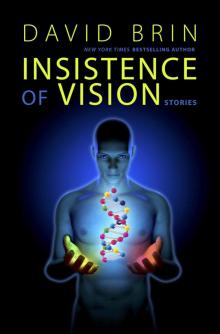 Insistence of Vision
Insistence of Vision Sundiver
Sundiver Brightness Reef
Brightness Reef Existence
Existence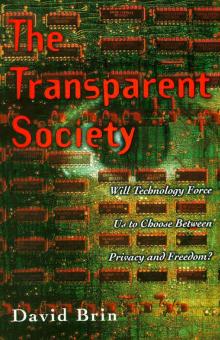 The Transparent Society
The Transparent Society Startide Rising
Startide Rising The Postman
The Postman The Uplift War
The Uplift War The Loom of Thessaly
The Loom of Thessaly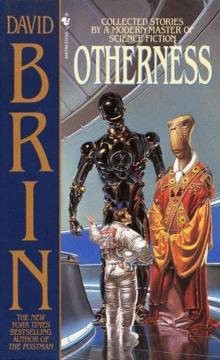 Otherness
Otherness Sundiver u-1
Sundiver u-1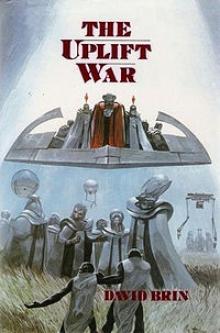 The Uplift War u-3
The Uplift War u-3 Infinity's Shore u-5
Infinity's Shore u-5 Brightness Reef u-4
Brightness Reef u-4 Uplift 2 - Startide Rising
Uplift 2 - Startide Rising Kiln People
Kiln People Heaven's Reach u-6
Heaven's Reach u-6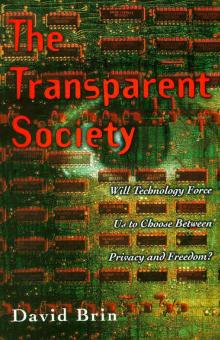 The Transparent Society: Will Technology Force Us to Choose Between Privacy and Freedom?
The Transparent Society: Will Technology Force Us to Choose Between Privacy and Freedom? Star Wars on Trial
Star Wars on Trial Lungfish
Lungfish Tank Farm Dynamo
Tank Farm Dynamo Just a Hint
Just a Hint A Stage of Memory
A Stage of Memory Foundation’s Triumph sf-3
Foundation’s Triumph sf-3 Thor Meets Captain America
Thor Meets Captain America Senses Three and Six
Senses Three and Six The River of Time
The River of Time Chasing Shadows: Visions of Our Coming Transparent World
Chasing Shadows: Visions of Our Coming Transparent World Foundation's Triumph
Foundation's Triumph Startide Rising u-2
Startide Rising u-2 The Fourth Vocation of George Gustaf
The Fourth Vocation of George Gustaf The Heart of the Comet
The Heart of the Comet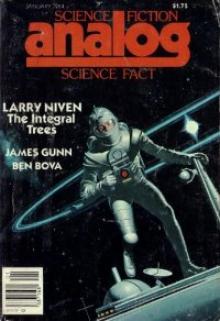 The Crystal Spheres
The Crystal Spheres